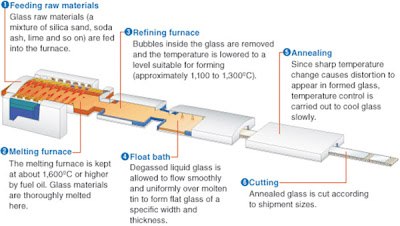Monday, January 17, 2011
What is Float Glass?
Initially, window glasses were made by cutting from large discs of Crown glass. Crown glass is nothing but a large globe of glass, made by blowing molten glass into a crown or a hollow globe. The crown glass is further reheated and spinned out of the globe into large discs, which were then flattened using centrifugal force. These glasses were then cut into desired sizes. There were other methods of making glass as well, like the blown plate, broad sheet, polished plate and cylinder blown sheets, which were all in practice up till the end of the 19th century. 20th century witnessed more advanced processes like rolled plate, machine drawn cylinder sheet, flat drawn sheet, single and twin ground polished plate and float glass.
The latest, advanced and widely used in our times is the float glass manufacturing process. Since I'm not from an engineering background, I would be able to explain this process only like how I learned it like a common man. The float glass process was invented by Sir Alastair Pilkington and Kenneth Bickerstaff. The major raw material used for making glass is Silica Sand, along with it are added soda ash (sodium carbonate), dolomite, limestone, and salt cake) etc. Each of these raw materials have a significant role to play and contribute to the formation of glass as the end product. Broken glass, is processed and added to the raw material batch (also called cullet), acts as a flux, bringing down the energy required to make molten glass. The furnace is heated up to 1500°C, the molten liquid inside this furnace is then let to flow through molten Tin, it floats due to the difference in density. This floating is what renders the flatness to the glass. The molten glass is then cooled in a controlled manner, this stage is known as annealing, any sharp decline would cause distortion to appear on the glass, that is why the cooling happens in a controlled manner. After all this, the glass is cut to sizes and then packed.
Major companies that manufacture float glass in India are Asahi India Glass Ltd (AIS), Gujarat Guardian Ltd (Modiguard), Saint Gobain Glass, Hindustan National Glass, Sejal Architectural Glass Ltd (now Sezal), and Gold Plus Glass Industry Ltd. Modiguard was the first float glass brand in India.
http://www.modiguard.co.in/
http://www.asahiindia.com/float.htm
http://www.saint-gobain.co.in/
http://goldplusgroup.com
http://www.sejalglass.co.in/float.htm
http://www.hngfloat.com/history.html
Labels:
float glass,
Glass in India,
manufacturing process
Subscribe to:
Post Comments (Atom)

No comments:
Post a Comment